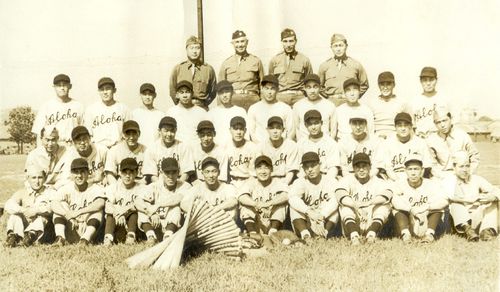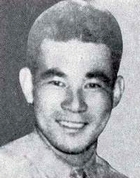Masa Takeba
| Date and Place of Birth: | April 24, 1918 Honolulu, Hawaiian Islands |
| Date and Place of Death: | January 10, 1944 near San Vittore, Italy |
| Baseball Experience: | Amateur |
| Position: | Unknown |
| Rank: | Sergeant |
| Military Unit: | Company B, 100th Infantry Battalion US Army |
| Area Served: | Mediterranean Theater of Operations |
With utter disregard for his own safety, Sgt Takeba ran over
the open terrain to his wounded comrade. Although bullets were flying
all around him, Sgt Takeba picked up the man and carried him 75 yards
over exposed rocky terrain to a covered position.
Award of Oak Leaf Cluster for Silver Star (posthumously)
Masaharu "Masa" Takeba was born on April 24, 1918 in Honolulu, Oahu.
He attended McKinley High School, Oahu.Before entering the service, he
was employed as a table captain at the Hawaiian Pineapple Company in
Honolulu.
Takeba was inducted in the Army on June 30, 1941 and initially served
with the 298th Infantry Regiment at Schofield Barracks. Like many people
in Hawaii, he was Nisei - second-generation Japanese, and on December 7,
1941, when the Japanese attacked the US fleet at Pearl Harbor,
everything changed. Americans of Japanese ancestry in Hawaii were
treated with suspicion and those in military service found their duties
suddenly reduced to menial tasks.
Eventually, the 100th Battalion was formed, a fighting unit made up
entirely of second-generation Japanese. Shiyama took basic training with
the 100th at Camp McCoy, Wisconsin, and quickly became a part of the
100th "Aloha" baseball team. The Aloha team initially played against the
military police unit at Camp McCoy but soon found competition in nearby
towns. In February 1943, the 100th Battalion moved to Camp Shelby,
Mississippi for advanced unit training where the Aloha team continued to
play.
The 100th Battalion left Camp Shelby for North Africa on August 11,
1943. They landed at Oran, Algeria on September 2, where they guarded
supply trains for a couple of weeks. It was in North Africa that the
Aloha baseball team played their last game. Challenged by the 133rd
Infantry Regiment, the 100th called upon Lieutenant Paul E. Froning, who
had just joined them. Froning would pitch in the minors after the war
and helped defeat the 133rd, 26 to 0.
On September 19, 1943, the 100th Battalion left the relative safety of
North Africa for Italy. They landed at Salerno and went into combat
against the Germans on September 29.
Sergeant Takeba, who had earned a Silver and Bronze Star, was killed in
action on January 9, 1944 near San Vittore, Italy. He was posthumously
awarded an Oak Leaf Cluster for his Silver Star. The citation read:
For gallantry in action on 7 January 1944, in the vicinity of
Cervaro, Italy. Sgt. Takeba, acting as platoon sergeant led his men in
occupying part of the north end of Hill 1109, without knowing that the
enemy was on the top of hill approximately 200 yards away. With
excellent observation the enemy immediately delivered heavy mortar,
machine gun and rifle fire on Sgt Takeba and his platoon. One of his men
was hit by an enemy sniper and seriously wounded. Notifying his
second-in command that he was going to advance forward and at the same
time take the wounded man to cover, he instructed the platoon to cover
his advance.
With utter disregard for his own safety, Sgt Takeba ran over the open
terrain to his wounded comrade. Although bullets were flying all around
him, Sgt Takeba picked up the man and carried him 75 yards over exposed
rocky terrain to a covered position. By his heroic deed in the face of
heavy enemy fire, Sgt Takeba saved the life of his comrade who
undoubtedly would have been killed if left on the open terrain exposed
to further enemy fire.
The coolness, courage and excellent leadership of Sgt Takeba was
highly commendable and in keeping with the finest traditions of the
military service.
Masa Takeba is buried at the National Memorial Cemetery of the Pacific
in Hawaii.

100th Battalion baseball team
Thanks to Kerry Yo Nakagawa of the Nisei Baseball Research Project and Hawaii State Library for help with this biography. Photo of 100th Battalion team courtesy of Sons and Daughters of the 100th Infantry Battalion Archives. Visit www.ajawarvets.org for more information on Americans of Japanese ancestry servicemen.
Date Added: February 8, 2013
Baseball's Greatest Sacrifice is associated with Baseball Almanac
Baseball's Greatest Sacrifice is proud to be sponsored by




